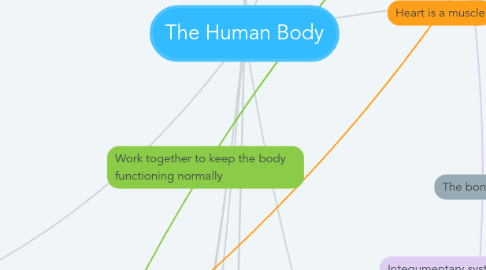
1. Allows movements
2. Lymphatic (Immune) System
2.1. Main organs include:
2.1.1. Spleen
2.1.1.1. Located in the upper-left part of the abdomen under the rib cage
2.1.1.2. Mainly filters blood, removing old or damaged red blood cells to be phagocytized by macrophages
2.1.1.3. Also detects viruses and bacteria and triggers the release of lymphocytes in response
2.1.2. Appendix
2.1.2.1. Pouch of lymphatic tissue attached to the large intestine in the lower-right area of the abdomen
2.1.2.2. Doesn't really have a clear function, but it does release mucus into the large intestine
2.1.3. Thymus
2.1.3.1. Located just under the neck in something called the thoracic cavity
2.1.3.2. Made up of two lobes, each consisting of a medulla and a cortex
2.1.3.2.1. Cortex
2.1.3.2.2. Medulla
2.1.3.3. Is large at birth but shrinks in size, no one really knows why
2.1.4. Tonsils
2.1.4.1. masses of lymphoid tissue in the back of the throat and nasal cavity
2.1.4.2. Removing the tonsils doesn't really increase susceptibility to infections
2.2. Main function
2.2.1. Protects against disease
2.2.2. Stores/ generates white blood cells
2.2.3. Transports lymph, a fluid containing white blood cells, throughout the body to necessary areas.
3. Skeletal System
3.1. Main functions includes:
3.1.1. Supports and protect vital organs
3.1.2. Stores minerals
3.1.3. produces red blood cells
3.2. Main organs include:
3.2.1. Cartilage
3.2.2. Ligaments
3.2.3. Tendons
3.2.4. Bones
4. Muscular System
4.1. Main function
4.1.1. Produces movement
4.1.1.1. Voluntarily
4.1.1.2. Involuntarily
4.2. Main organs include
4.2.1. Types of muscles which include:
4.2.1.1. Skeletal
4.2.1.2. Smooth
4.2.1.3. cardiac
5. Integumentary System
5.1. Main organs include:
5.1.1. Skin
5.1.1.1. Secretes sweat for cooling
5.1.2. Hair
5.1.3. Nails
5.1.4. Sweat glands
5.2. Function:
5.2.1. Barrier against:
5.2.1.1. Infections
5.2.1.2. UV radiation
5.2.1.3. Changes in temperature
6. Nervous System
6.1. Main function
6.1.1. Regulates the body's responses to changes both:
6.1.1.1. Internal
6.1.1.2. External
6.1.2. Process information by using neurons to create impulses
6.2. Main organs include:
6.2.1. Brain
6.2.2. Spinal cord
6.2.3. Peripheral nerves
7. Excretory System
7.1. Excretory System
7.1.1. Main organs include:
7.1.1.1. Skin
7.1.1.2. Lungs
7.1.1.3. Kidneys
7.1.1.3.1. filters waste products
7.1.1.4. Bladder
7.1.2. Main function:
7.1.2.1. eliminates/excrete waste
7.1.2.2. Maintains homeostasis
8. The Circulatory System
8.1. Main Organs include:
8.1.1. Heart
8.1.2. Blood Vessels
8.1.2.1. Veins
8.1.2.2. Arteries
8.1.3. Blood
8.1.4. Lymph Nodes
8.1.5. Lymphatic Vessels
8.2. Main Function:
8.2.1. Transports:
8.2.1.1. Oxygen
8.2.1.1.1. oxygen in the lungs gets diffused to the blood stream
8.2.1.2. Nutrients
8.2.1.3. Waste
8.2.2. Brings the specific delivery to its destination and brings the blood cells to the lungs for resupplying with oxygen
8.2.3. Regulates body temperature
9. Reproductive System
9.1. Male
9.1.1. Main organs include:
9.1.1.1. Testes
9.1.1.2. Penis
9.1.1.3. Associated ducts and glands
9.1.2. Main function:
9.1.2.1. Produces reproductive cells
9.2. Female
9.2.1. Main function:
9.2.1.1. Produces reproductive cells
9.2.1.2. Provide environment for embryo
9.2.2. Main organs include:
9.2.2.1. Ovaries
9.2.2.2. Fallopian Tubes
9.2.2.3. Uterus
9.2.2.4. Vagina
10. Digestive System
10.1. Main organs include:
10.1.1. Mouth
10.1.2. Pharynx
10.1.3. Esophagus
10.1.4. Stomach
10.1.5. Intestines
10.1.5.1. Small
10.1.5.2. Large
10.1.6. Pancreas
10.1.7. Gallbladder
10.1.8. Liver
10.2. Main functions:
10.2.1. Break down and absorb:
10.2.1.1. Nutrients
10.2.1.2. Salts
10.2.1.3. Water
10.2.2. Eliminate some waste
11. Respiratory System
11.1. Main organs include:
11.1.1. Nose
11.1.2. Sinuses
11.1.3. Pharynx
11.1.4. Larynx
11.1.5. Trachea
11.1.6. Lungs
11.2. Main function:
11.2.1. Delivery of oxygen for cells
11.2.2. Expels
11.2.2.1. Carbon Dioxide
11.2.2.2. Water vapor
12. Endocrine System,
12.1. Endocrine System
12.1.1. Main function:
12.1.1.1. Helps maintain homeostasis
12.1.1.2. Influences:
12.1.1.2.1. metabolism
12.1.1.2.2. growth
12.1.1.2.3. development
12.1.2. Main organs include:
12.1.2.1. Hypothalamus
12.1.2.2. glands including:
12.1.2.2.1. pituitary
12.1.2.2.2. thyroid
12.1.2.2.3. parathyroid
12.1.2.2.4. adrenal
12.1.2.3. Pancreas
12.1.2.4. Ovaries
12.1.2.5. Testes

